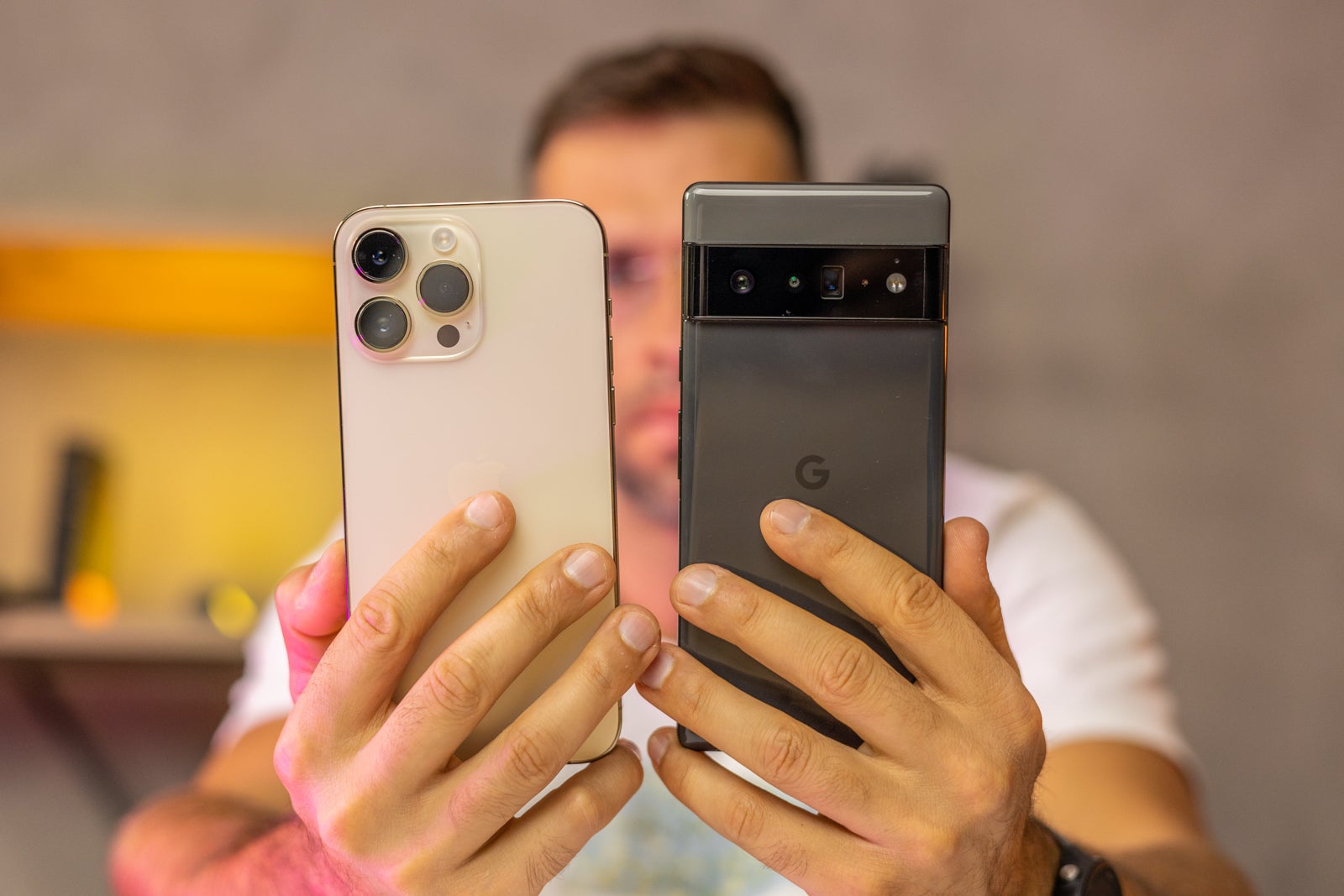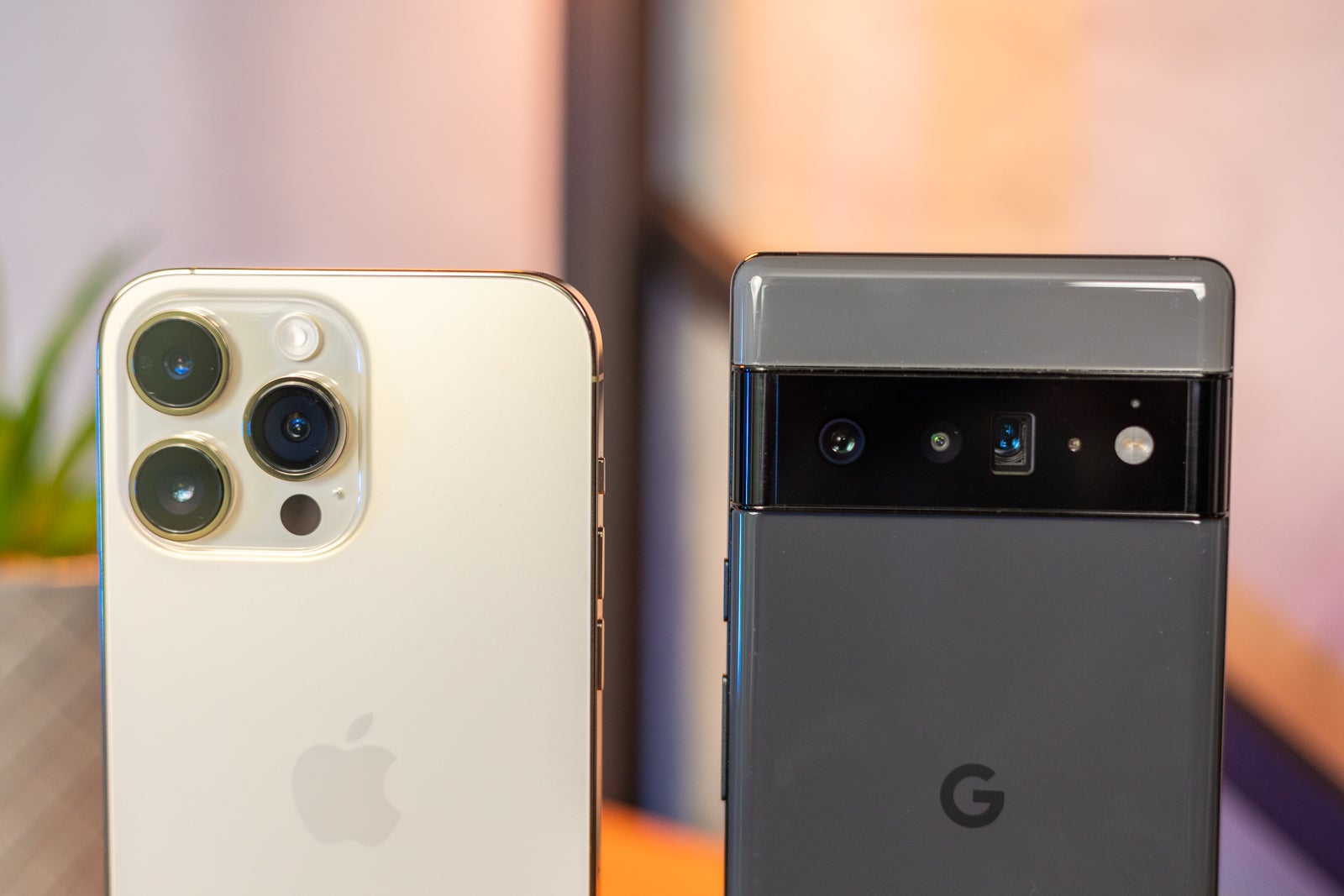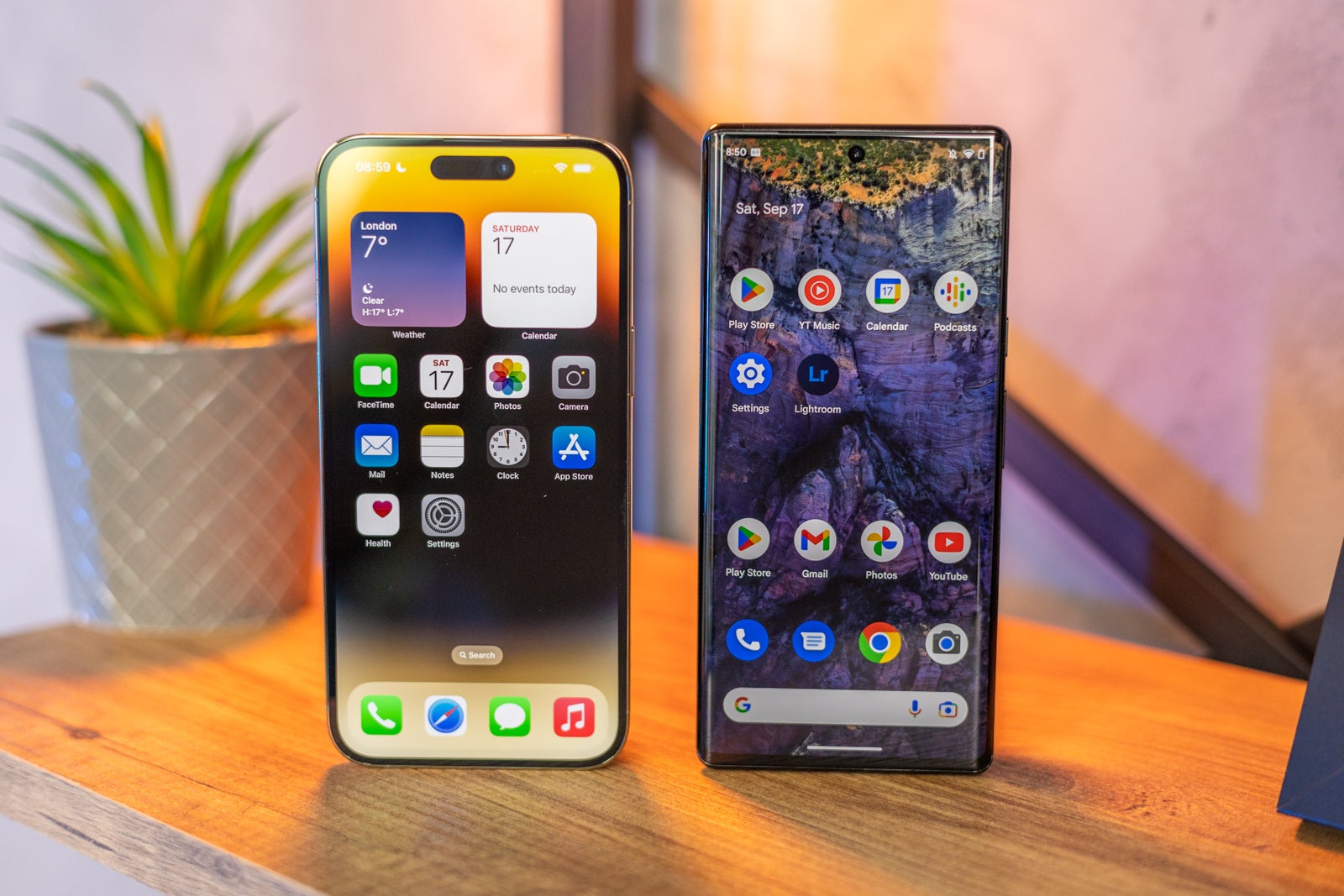Intro
Of course, there is an obvious disadvantage on Google’s side here, as the Pixel 6 Pro is almost 1 year older by this point, so you can be sure we will do another comparison with the most high-end Pixel 7 model when that comes out (which it should pretty soon).That being said, the simple fact that we are talking about two different operating systems here leaves us with plenty of room and opportunities to have an interesting battle between these iOS and Android champs.
iPhone 14 Pro Max vs Pixel 6 Pro in a nutshell:
- Pixel 6 Pro has a higher resolution display
- iPhone 14 Pro Max has a longer battery life
- Pixel 6 Pro has better AI capabilities
- iPhone 14 Pro Max has better selfie camera
- Pixel 6 Pro comes with more optical zoom
- iPhone 14 Pro Max has a brighter display
Table of Contents:
Design and display quality
The iPhone finally looses the notch
(Image Credit – PhoneArena) iPhone 14 Pro Max vs Pixel 6 Pro design differences
Design-wise, Google brought something fresh to the table when it introduced the Pixel 6 and 6 Pro. Some loved it, some hated it, but its looks were what made it stand out the most.
Apple, however, likes to play it a bit safer when it comes to changing the way its products look. The iPhone 14 Pro Max is somewhat uninspired, with one exception — the new pill-shaped cutout that replaces the notch. Now, this is hardly a new look on a phone, but Apple has made this screen intrusion into a feature, calling it “Dynamic Island”.

iPhone 14 Pro Max Dynamic Island in action.
Display Measurements:
Water and dust resistance are usually a given when we enter the flagship realm. The Pixel 6 Pro has an IP 68 rating, and the same goes for the iPhone 14 Pro Max. Biometrics are also worth mentioning here, as the ones on the Pixel 6 Pro have a bad reputation of being buggy, while despite not having any fingerprint scanning, iPhones Face ID system tends to work quite well.
Performance and Software
Awesome power or AI and smart features

(Image Credit – PhoneArena) iPhone 14 Pro Max vs Pixel 6 Pro
Google debuted its first-ever in-house chip with the Pixel 6 and 6 Pro called Tensor. Tensor is not exactly known for being the fastest chipset in terms of raw CPU and GPU power so it might seem like a disappointment at first for some.
You see, Google knows what it is best at — AI. That is why when it made its first chipset, the search engine giant decided to focus its resources on AI computing, with one of the best examples being the Google Assistant and photo processing.
Benchmark Results:
Things look way different on Apple’s side, though. With iPhones, it is all about power and efficiency. The iPhone 14 Pro Max comes with the A16 Bionic, which offers tremendous horsepower for intensive tasks like shooting high resolution HDR video, or playing graphic-intensive games.
Camera
New camera = Pixel left in the dust?

(Image Credit – PhoneArena) iPhone 14 Pro Max vs Pixel 6 Pro cameras
When we talk about camera systems on the absolute best flagships, things can get a little subjective. The Pixel phone became popular thanks to its main selling point of having an awesome camera powered by AI that is capable of taking some of the best images with a phone.
Now, when it comes to taking snapshots the Pixel is still one of the best phones out there. But the iPhone 14 Pro Max is comes with a brand new 48MP sensor powering the main camera.
Main Camera
With a similar, 24mm focal distance, shots from the main cameras of the iPhone and the Pixel look similar, yet when you take a closer look, you notice some very clear differences in the processing. The iPhone lets the highlights blow up and the wall of the building in the left half of the picture is burned on the iPhone. The Pixel produces a much more HDR-y look, controlling tightly both the highlights from burning out and the shadows from being way too crushed, and you get this flatter looking image, but one with clearly better dynamic range.
Ultra-wide
Switching to the ultra-wide camera, the iPhone offers a 13mm field of view, much wider than the 17mm one on the Pixel.
But thanks to that wider perspective, in challenging conditions with bright sunlight, we see the issues with burned highlights even more pronounced on the iPhone’s ultra-wide camera, while the Pixel once again delivers an image with tightly controlled highlights and shadows, and in our view, is the clear winner here.
Zoom
With some clever processing, the iPhone is able to deliver a slightly cleaner image at 2X zoom, but a 2X picture from the Pixel is really close in terms of quality, and that is without Google ever bragging about it.
Then, it’s up to you to decide which lens you find more useful: the 3X zoom one on the iPhone doubles as a portrait mode lens, while the 4X zoom lens on the Pixel is not used for portraits, but is just perfect for pictures of pets, where the 3X focusing distance is usually not quite enough. And anything further than 4X the Pixel wins easily.
Portrait Mode
The one area where the Pixel 6 Pro fails miserably in comparison with the iPhone 14 Pro Max (and pretty much any other flagship phone out there) is portrait mode. You cannot actually preview portrait mode shots in the Pixel 6 viewfinder, but since it uses digital crop, there is a huge loss in detail.
The wider portrait setting on the Pixel is nearly equivalent to the 2X mode on the iPhone (the Pixel cannot go any wider for portraits), but if you switch to the zoomed-in portrait mode view is where photos from the Pixel just look terrible. Clear win for the iPhone!
Front Camera
Last but not least, we have an upgraded front-facing camera living inside that new oval-shaped punch hole on the iPhone 14 Pro Max, which now comes with auto focus and can capture better low-light performance. The auto focus alone is plenty to put Apple’s phone ahead.
Audio Quality and Haptics
A win-win situation
The dual speakers on the Pixel 6 Pro are quite loud, producing a rich sound that’s pleasing to the ears. As for the iPhone 14 Pro Max, it comes with the same set from its predecessor, so top notch quality there as well.
As for haptics, the iPhone usually has no trouble in that department. However, that also stands true for the Pixel, at least in more recent years, so we can expect the two to perform similarly here too.
Battery Life and Charging

(Image Credit – PhoneArena) iPhone 14 Pro Max vs Pixel 6 Pro
In terms of battery size, the iPhone comes with 4323mAh while the Pixel with 5003mAh. The larger battery might lead you to thinking the latter has a much better battery life, but there are many factors at play here. Even if we look at the benchmark results from the iPhone 13 Pro Max vs Google Pixel 6 Pro comparison, it quickly becomes clear who is the clear winner:
PhoneArena Battery Test Results:
Both Apple and Google advertise their top flagships as being able to charge up to 50% in 30 minutes. Both also have wireless charging, however, only the Pixel supports reverse wireless charging.
| Specs | iPhone 14 Pro Max | Pixel 6 Pro |
|---|---|---|
| Dimensions | 6.33 x 3.05 x 0.31 inches (160.7 x 77.6 x 7.85 mm) | 6.45 x 2.99 x 0.35 inches (163.9 x 75.9 x 8.9 mm) |
| Weight | 8.47 oz (240.0 g) | 7.41 oz (210.0 g) |
| Screen | 6.7 inches, OLED, 120Hz, HDR | 6.7 inches, P-OLED, 120Hz, HDR |
| Processor | Apple 16 Bionic | Tensor |
| RAM | 6GB | 12GB |
| Rear Cameras | 48 MP main, 12 MP ultra-wide, 12 MP 3x telephoto | 50 MP main, 48 MP 4x telephoto, 12 MP ultra-wide |
| Front Camera | 12 MP (Autofocus, HDR) | 11.1 MP |
| Battery Size | 4,323mAh | 5003 mAh |
| Charging Speeds | Wired: 27.0W; Wireless: 15.0W | Wired: 30.0W; Wireless: 23.0W |
| Price | $1,099 | $899 |
Summary and Final Verdict
So… is making the transfer from one camp to the other worth it for the iPhone 14 Pro Max? Well, that depends on whether you see yourself as belonging to one camp or not. If you have not pledged allegiance to either manufacturer, then the question becomes more easily debatable.
The iPhone 14 Pro Max is a 1-year newer than the Pixel 6 Pro, but also $200 more expensive. Improvements in performance, the camera, longer battery life, etc., are all advantages worth considering when deciding which one to pick. It’s also worth mentioning that iPhones tend to be more stable software-wise, at least compared to the current Pixel models.
That being said, the Pixel 6 Pro is still a great phone to have for its price, although we should be getting the brand new Pixel 7 lineup sooner rather than later. So, in other words, it might be worth waiting a bit to see what Google comes out with this year, instead gunning for a new phone right at this moment.

